SEJournal Online is the digital news magazine of the Society of Environmental Journalists. Learn more about SEJournal Online, including submission, subscription and advertising information.
 |
 |
| Spotted salamander larvae developing in egg mass clusters, almost ready to hatch, sit suspended in a vernal pool, in Amherst, Maine, on June 5, 2021. A species of green algae, Oophila amblystomatise, share space inside the egg casings with the spotted salamander larvae. While common in corals, it is the only algae endosymbiosis involving a vertebrate species, and their symbiotic coexistence is the subject of an ongoing study that has much broader implications. Photo: Tristan Spinski. (View more images.) |
EJ InSight: Photographing Vernal Pools, ‘Another Universe’ in Your Backyard
Introduction and interview by Andrew Cullen
As a child, any visit to my grandmother involved wandering down to the patch of soggy woods behind her house just outside of Worcester, Massachusetts. We called it a swamp, and perhaps some of the pools were present year-round, but much of it came and went with the seasons. The ownership of these few acres was unclear, but certainly no one had much use for it. No one except for my grandmother, that is: She forged paths throughout, laying down scrap wood to bridge the especially squishy spots. I loved when a tree would fall over during a storm, its root system pulling the intact soil from the saturated earth to form walls taller than I was, which I could then inspect for insects and salamanders. She loved the birds that inhabited her seemingly private suburban oasis.
While my grandmother lived alone for many decades, I suspect that her daily forays into those watery woods were a key ingredient in the recipe that kept her going till the age of 96. And with the understanding that this easily ignored environment held great value for our lives, as well as animals, I was excited to see photographer Tristan Spinski’s project on the vernal pools of Maine published as a feature, “Where the Forest Springs Eternal,” in the February issue of National Geographic (subscription required).
Spinski has granted these overlooked
but essential ecosystems the depth
of coverage typically reserved
for charismatic megafauna.
In a series of seasonally sequential landscapes, aerials and portraits of creatures more likely to be stepped on than given the studio treatment, Spinski has granted these overlooked but essential ecosystems the depth of coverage typically reserved for charismatic megafauna. His images draw us into a world so mundane and yet so interconnected that we risk missing its beauty and its importance. “This photo is like another universe,” another photographer commented, on a close-up image Spinski posted to Instagram, showing a spotted salamander larva and the algae that infuses not just the egg sac but the salamander’s own cells, forming a symbiotic relationship of nutrient-sharing between the species.
While the project was executed with the backing of National Geographic, I wondered what insights Spinski’s work on a subject in his relative backyard — the photographer is based in Portland, Maine — might offer to others interested in covering the minor-seeming or even inconvenient landscapes in theirs. He offered to answer some questions about how he approached a complex ecosystem whose defining feature is its disappearance; his responses via email follow.
Andrew Cullen: How did you become interested in vernal pools? Is this something that you pitched to National Geographic?
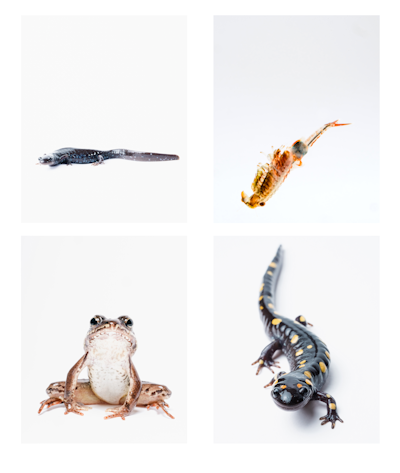 |
| The four indicator species for vernal pools in Maine (clockwise from top left): blue-spotted salamander complex, fairy shrimp, spotted salamander and wood frog. They exclusively depend on vernal pools to breed, as their temporary hydroperiods ensure the absence of fish. Photo: Tristan Spinski. |
Tristan Spinski: About seven years ago, I took an assignment from Science magazine to make a portrait of Aram Calhoun, a wetland ecologist and conservation biologist, who at the time was teaching at the University of Maine (she has since retired). Aram studies vernal pools — small, ephemeral wetlands in the forest. When I took the assignment, I had never heard of a vernal pool. I met Aram at her home in rural, inland Maine, in midsummer, and we took a short walk into the forest on her back acreage, as she has a vernal pool on her property — an appropriate setting for the portrait.
These small natural landscape features have a defining characteristic: They dry down in the summertime. Fish can’t survive in them, which means amphibians’ eggs and larvae have a better chance of survival. Being midsummer, the vernal pool on her property was almost completely dry, to the point where I described it upon returning home as a “puddle.” And in that situation, having never heard of a vernal pool and talking with a scientist who had spent her life studying these very humble landscape features and associated ecologies, I understood that she was tuned in to a landscape and a world of interconnected ecological complexities that I was completely unaware of. I wanted to learn more.
And so I did what I tend to do when I have an idea: nothing (except think about it and read about it and obsess over it). I used to beat myself up over that process, but really it’s useful. If it’s still taking up space after a year or so, then I understand it’s more than a whim and worth pursuing. I reconnected with Aram, explained my interest and started making trips out to the vernal pool to explore. I understood they are all over the place, but I wanted to explore the one on her property because she could answer my questions. I had no idea what I was doing or what I was observing, and she had all of the answers.
I spent about a year making
random trips to her property,
poking around in the vernal pool,
... and trying to figure out, practically,
how best to document this landscape.
I spent about a year making random trips to her property, poking around in the vernal pool, getting bit by mosquitoes and trying to figure out, practically, how best to document this landscape. This was all outside of my assignment work. I was just exploring. When Samantha Clark, an editor from National Geographic, reached out and asked me if I had any ideas for a magazine feature, I initially pitched another project that I thought would be right up their alley. But they passed. As we were exchanging “maybe next time” emails she mentioned there was a forest-centric issue in the works, and I brought up my interest in vernal pools. The pitching process was extensive, months actually. But it was greenlighted and three years later and more than 100 days in the field, we have a magazine feature on vernal pools.
Making the simple infinitely beautiful
Cullen: How did you begin to engage with the subject? How did you settle on a process and a visual approach to this story?
Spinski: I refer to vernal pools as “humble” landscape features. When you come across one in the forest, it can be underwhelming. But just because it’s not a spectacle on first pass doesn’t mean it’s not there. “Simplify” was the advice my father preached. I say it aloud to myself all of the time. And so with that mantra in mind, I set out to deconstruct the vernal pool — by season, by species, by life-cycle stage, by any and all ingredients that inform its structure and function.
I thought that if we could present keystone species outside of the visual chaos in which they exist, convey seasonal scenes that illustrate how weather and climate influence the temporary hydroperiods that define vernal pools, capture a selection of truly extraordinary situations and moments unfolding above and below the water’s surface that involve common species that depend on vernal pools, then we might be able to harness the “megaphone” of National Geographic and show people, at scale, how remarkable and ecologically significant vernal pools are. I wanted to demonstrate that even the most seemingly simple, ordinary things can be infinitely beautiful and complex, and that it’s happening everywhere.
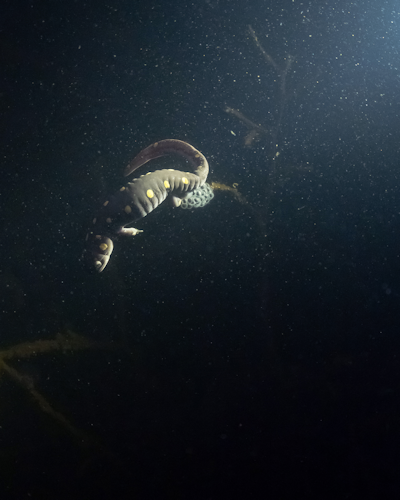 |
| Amphibians dependent on vernal pools spend the vast majority of their time in surrounding forests migrating annually to the vernal pools to breed. Above, a female spotted salamander deposits her eggs on a submerged stick in a vernal pool in Brunswick, Maine, on April 18, 2023, during the annual “Big Night” — an annual event where amphibians migrate from the upland forests to breed. During this period, male salamanders gather in groups, called a “congress,” and deposit spermatophores on submerged leaf litter and underwater structures, which are then picked up by females to fertilize their eggs, which they deposit in small egg masses on underwater structures and debris. Photo: Tristan Spinski. |
Cullen: Did the project make you think differently about conservation, or what species and landscapes we collectively value or choose to preserve?
Spinski: I’m interested in the “ordinary.” It takes a bit more of an attention span to spend time with less charismatic species and spaces. I learned so much about conservation and forest connectivity from Aram and her husband and research partner, Mac Hunter. And I think the overarching lesson that I absorbed from Aram and Mac, as well as from my time in the forest, is that everything matters.
Cullen: The final story included a mix of images from the field, as well as ones made in the studio. Did you have to learn to use different tools or techniques to work on this?
Spinski: I’m more comfortable with studio work. But I had no experience working underwater. And I underestimated the challenges involved: remote forests, late at night, often in the rain, near-freezing water that I could only stand to be in for two hours at a time, shallow and stagnant freshwater with deep sediment beds that, when disturbed, turned into underwater blizzards of muck and debris, and most challenging — extremely shy amphibians that are only active at night and only present in the vernal pools for a few days a year.
My editor connected me with Nat Geo’s engineer, Tom O’Brien. We had multiple calls and emails where I explained what I wanted to do, and he has such an enormous wealth of experience facilitating photographers to accomplish their goals in super-challenging conditions. He put together a dream gear kit for me to work with, as well as provided support throughout the project.
Cullen: Was it a challenge to remove the various creatures you photographed in studio settings from their habitat and get them back safely? How did you do that?
Spinski: I always set up a makeshift studio near the vernal pool, so that any of the smaller (and common) species, like a wood frog, a spotted salamander or some of the invertebrates like the caddisfly, could be carefully handled and photographed, and then returned right away to the vernal pool from which they came from. For many of the turtle species, and anything more rare, fragile and/or sensitive, I worked with field biologists who were safely and temporarily capturing the animals for their own field surveys and research purposes, to which I gained permission to hitch a ride on. For the birds included, I used trail cameras to document the presence of a species at the vernal pool sites. I had lots of trail cam footage of barred owls and the broad-winged hawks hunting in the vernal pools.
Knowing what was there, I worked with a regional wildlife education and rehabilitation center that had trained vets and handlers on staff to photograph several birds that were permanent residents of the facility because of health issues or physical impairments. Those birds serve as educational "ambassadors" for the wildlife rehab center, so this was a natural extension of those roles, only now they became ambassadors for vernal pools.
Strategies to ‘simplify’
Cullen: Most photographers don't have access to the technical resources that National Geographic provides. But do you have any advice for photographers on how to approach the "humble landscapes" or less charismatic keystone species in their own backyards?
Spinski: I was going to photograph a project on vernal pools no matter what, because I love this idea of seemingly simple things being infinitely complex. The equipment that National Geographic provided enabled me to create a body of work appropriate for National Geographic. Before that all came about, I was photographing the vernal pool landscapes with a 4x5 field camera and scheming on ways to rig a fish tank to a Mamiya RZ to partially submerge the gear in the shallow pools.
I don't think any of my favorite
work of other photographers
has ever depended on
impressive equipment.
My point is that the equipment helped take the photography to the client's standards, but it could have gone a completely different (and possibly lovely) path had they not signed on. I don't think any of my favorite work of other photographers has ever depended on impressive equipment. Two bodies of work in "nature photography" that stand out as exceptional examples are "Murmurations" by Richard Barnes and "Dark Sharks" by Karen Glaser. And seeing these works early in my career was enormously influential.
Now, years later, I realize that it holds true to my father's ethos of “simplify." In the context of turning the camera toward less charismatic species, there are a few strategies to move the work forward: Read up and learn as much as you can, team up with a collaborator with in-depth expertise, honor the impulse of curiosity and start making work. It might lead where you think. But most likely, it'll take you somewhere much more interesting.
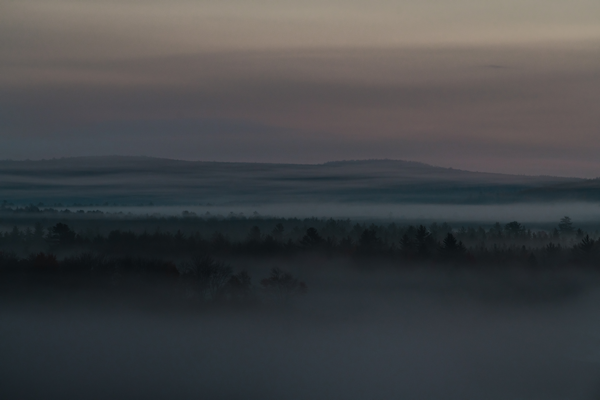 |
| Sunrise on the west branch of the Union River, Maine, as fall precipitation recharges the watershed and the plethora of vernal pools tucked into the forested landscape. Vernal pools are temporary and ephemeral landscape features that form a complex matrix of ecological interconnectivity, making them small “keystone ecosystems,” essential to the health of these glaciated New England forests, with ecological roles that far outsized their actual footprints. They serve as breeding grounds, refugia, food sources and stop-off points for both permanent forest fauna and refueling stations for animals migrating through, and are essential to the forests’ health and ecology. Photo: Tristan Spinski. |
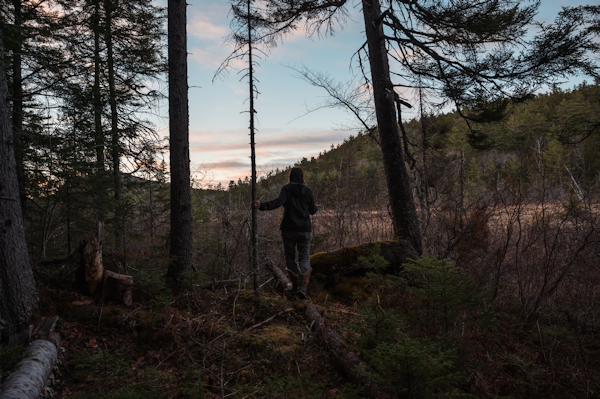 |
| Aram Calhoun, professor emerita of wetland ecology and conservation wildlife, fisheries and conservation biology at the University of Maine in Orono, Maine, walks into a fen, a peat bog that sits upstream from the primary vernal pool site, and is part of the Union River watershed in Amherst, Maine, photographed at dusk on April 12, 2021. Photo: Tristan Spinski. |
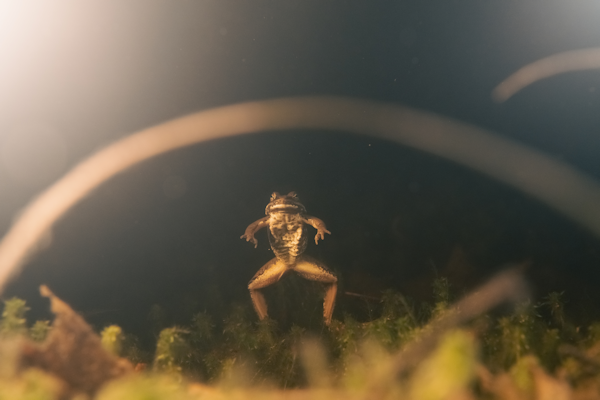 |
| A wood frog “stands up” on the bottom of a vernal pool during the annual spring breeding migration. Scientists believe salamanders and other amphibians are locally adapted to the water chemistry and pH of the soils, waterways and vernal pools to which they were born. These details are informed by a number of factors, including the geology and the fungal networks. Photo: Tristan Spinski. |
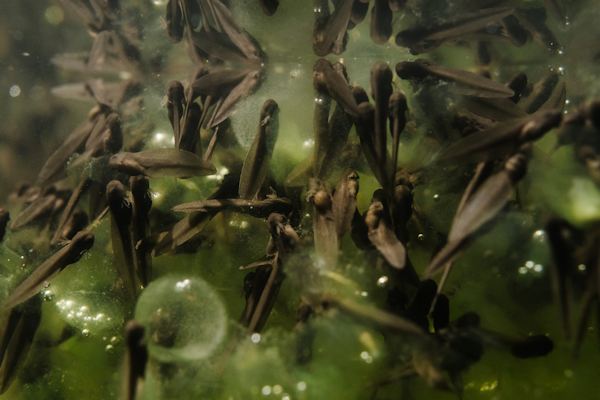 |
| A mass of freshly hatched wood frog tadpoles congregate at the north end of a vernal pool in Amherst, Maine on May 14, 2022. Wood frogs typically lay and attach their eggs to trees, plants and submerged debris on the northern side of vernal pools, given they’re usually the warmest end of the pools with their prolonged southern exposure to the sun. Photo: Tristan Spinski. |
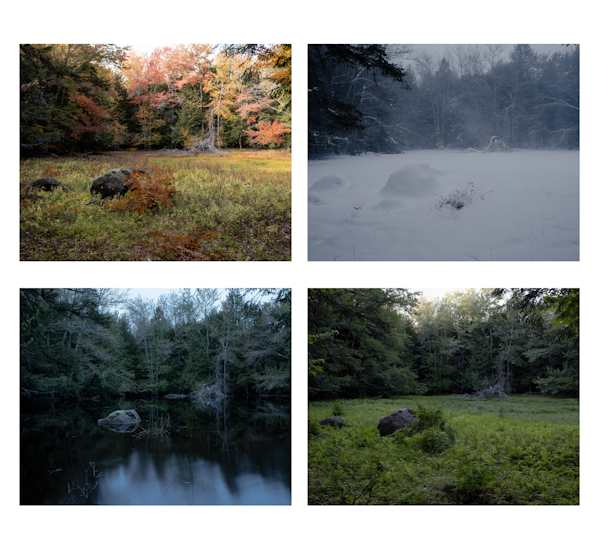 |
| A vernal pool in Maine as it appears throughout the four seasons. Photo: Tristan Spinski. |
Tristan Spinski is a photographer, writer and filmmaker. He earned his master's degree in journalism from UC Berkeley, and much of his work examines the intersections of culture, economy and the landscape. He lives in Maine. His editorial clients include Audubon, National Geographic, NPR and The New York Times, among many others.
Andrew Cullen was recently appointed co-editor of SEJournal’s EJ InSight. An independent photojournalist and a 2022-2023 Ted Scripps Fellow for Environmental Journalism at CU Boulder, his work examines the complicated relationships between the environment and individual and communal identities. He has photographed for The New York Times, NPR, CNN, Reuters and High Country News.
* From the weekly news magazine SEJournal Online, Vol. 9, No. 12. Content from each new issue of SEJournal Online is available to the public via the SEJournal Online main page. Subscribe to the e-newsletter here. And see past issues of the SEJournal archived here.












 Advertisement
Advertisement 



